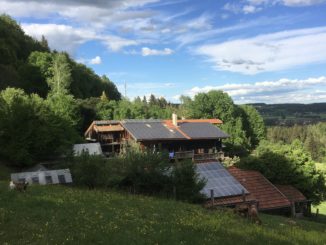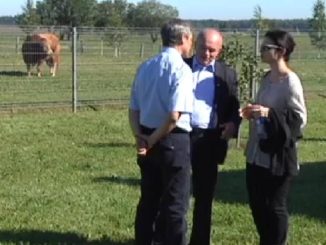 Negotiations on future policy options at the EU level are ongoing, setting the basic framework for future rural development policy. Among others the Rural Pact Coordination Group (RPCG) is working on a Joint Declaration to express its views of the future rural development policy. In this op-ed, Edina Ocsko of Smart Village Network Services / E40, who is Vice-Chair of the RPCG, argues that the EU must take a more proactive approach in delivering stronger supports for rural areas.
Negotiations on future policy options at the EU level are ongoing, setting the basic framework for future rural development policy. Among others the Rural Pact Coordination Group (RPCG) is working on a Joint Declaration to express its views of the future rural development policy. In this op-ed, Edina Ocsko of Smart Village Network Services / E40, who is Vice-Chair of the RPCG, argues that the EU must take a more proactive approach in delivering stronger supports for rural areas.
Unused potential of EU funding and the CLLD approach
Rural areas are at the heart of our common future. Beside their functions in sustainable food production and food security, sustainable tourism, and protection of natural and cultural heritage, rural areas are also at the heart of the green transition (including renewable energy, C sequestration, regenerative agriculture and beyond). Therefore, the survival of rural areas is not just the interest of those living in rural areas, but it is the interest of all of us. It follows that caring for and supporting rural areas and citizens is also our joint responsibility.
It is widely recognised that the sustainability and resilience of rural areas are at high risk. Rural areas and citizens are confronted with significant challenges, such as depopulation and ageing, further aggravated by the lack of services and of economic opportunities (local jobs), resulting in a vicious circle. Due to depopulation – especially young and/or highly educated people leaving ‘for good’ and related ‘brain drain’ – in many rural communities (especially in poorer parts of Europe) the more disadvantaged groups of inhabitants stay behind, resulting in small communities having significant capacity constraints. These limitations are also evident in areas such as strategic planning, generating new project ideas, implementing initiatives and projects, accessing public funding, and engaging in exchanges with other communities.
The EU’s Long Term Rural Vision for Rural Areas and the Rural Pact show the recognition of the importance of rural areas and a political commitment from the EU level towards better supporting rural areas and citizens. As frequently quoted from Ursula von der Leyen (President of the European Commission): “We stand by their side and want Europe’s rural areas to flourish. Europe is investing in rural areas because their prospects are Europe’s future.”
EU funding holds potential both in terms of addressing specific rural challenges and in terms of building capacity of rural communities. In particular, it is widely acknowledged that bottom-up, community-led local development (CLLD) approaches – such as LEADER and Smart Villages – can be highly effective in addressing not only local challenges, such as rural depopulation and service deficiencies, but also global issues, such as climate change.
In addition to LEADER, which has proved to be a highly successful method for distributing funds and targeting the real needs of rural communities locally, the EU’s new Smart Villages concept offers a crucial support mechanism at the very local rural community level. This concept not only complements but also revitalises the LEADER approach by extending its principles – such as strategic planning and participatory methods – directly to the local community level, while placing an even greater emphasis on social and technological innovation. As the LTVRA report highlights “[s]upport for ‘smart villages’ within and outside LEADER is expected to contribute to unlock the potential of digital, social and technological innovation in rural areas”.
However, during the past and current programming periods, the potential of EU policies and especially CLLD has not been fully exploited:
- Rural development, and especially CLLD approaches, are currently underemphasised and underfunded within the existing Common Agricultural Policy (CAP). Overall, the CAP is dominated by agricultural (sectoral) interests, a considerable proportion of direct payments going to very large farms – sometimes even to those with production methods that are neither good for the environment nor for society. CLLD approaches have consistently received minimal funding across successive programming periods. As the LTVRA Report highlights the absolute amount assigned to LEADER did not increase compared to the previous period, and “LEADER is expected to do more with less”.
- Similarly, while the introduction of Smart Villages has brought new opportunities to apply the CLLD approach at the very local level of rural communities; the initial enthusiasm towards the concept has not yet met with matching commitment to sufficiently programme and finance for Smart Villages. For the time being, Smart Villages has been incorporated into the CAP beyond the LEADER approach in only a few Member States , and has not been included under the Cohesion Policy programmes, despite its original conception as a multi-funded initiative.
- The multi-funded Community-Led Local Development (CLLD) approach, or even the CLLD approach under other funds, has not gained widespread adoption despite extensive encouragement and advocacy from the European Commission. Notably, countries (Sweden, Portugal and Slovakia) that experimented with a cohesion policy-funded element of CLLD, have abandoned this approach post-2023. Multi-funding in CLLD has been considered challenging (e.g. due to the administrative burden and harmonisation of funds).
- The Cohesion Policy also does not provide adequate support for rural areas. While there is some evidence that Cohesion Policy programmes target rural areas, there is lack of focused targeting of available support, as evidenced also by the fact that 79% of Cohesion Policy funds are not even territorially tagged, leaving it unclear whether rural areas are being supported. A recent study on Cohesion Policy (Nils Redeker et als., 2024) argued that “The [Cohesion Policy] funds frequently target places that are not particularly needy and mainly benefit people at the upper end of the income distribution. Cohesion policy thus requires root-and-branch reform. This includes sharper focus on truly disadvantaged areas, a more precise definition of local economic challenges, improved funding access for small municipalities and companies, and redirection of resources now allocated to wealthy member states towards an EU-level investment instrument.”
No more business as usual
So why despite all the seemingly strong political commitments at the EU level, rural development beyond agriculture has not received sufficient support and funding after programming-to-programming period? The reasons for lack of sufficient policy focus and funding for rural areas are easier to identify than to act upon.
Firstly, rural development has ‘fallen between two stools’ of CAP and Cohesion Policy over the past years. The CAP has been dominated by agricultural (sectoral) interests, leaving limited space to Pillar II priorities (and especially to CLLD); while Cohesion Policy is often dominated by the interest of urban areas and those of the most advanced and strongest regions, leaving the weakest rural areas and communities behind. This phenomenon is both the cause and the consequence of weaker and less structured interest representation of small and disadvantaged rural communities in policy negotiations, resulting in a vicious circle of neglect of rural interests when it comes to the distribution of EU funds.
Secondly, the ‘shared management system’ of EU funds has covered up for the regulatory shortcomings. When questioned about the critical shortcomings in rural development policy, the European Commission often cites the ‘shared management system,’ emphasising that Member States are responsible for how they use EU funds within the broader EU framework. While the flexibility afforded to Member States has been appreciated, it has proven insufficient — except in rare cases — in ensuring that Member States prioritise rural areas and effectively resource local rural development interventions.
Thirdly, programmes under direct management (with substantial EU funding) are no exceptions and also often tend to benefit the strongest players. For instance, due to the design of the programme (i.e. focus on research & innovation), Horizon programmes and projects – even when explicitly targeting rural communities – are ultimately benefitting large institutions (consultancies, research institutes, universities, etc.), also with the capacity and knowledge to apply successfully. Rural communities are only indirect (if at all) beneficiaries of these projects. For instance, Horizon Europe statistics show that 90% of Horizon Europe funds have benefitted directly higher education institutes (34%), private for-profit entities (29%) and research organisations (27%), while only 10% of funds have directly benefitted public bodies and other types of stakeholders.
These shortcomings highlight that business as usual is no longer an option. The EU must adopt a more proactive approach, implementing rules and regulations that require better harmonisation of the use of funds and ensure stronger support for rural areas. Just like acting upon climate change, we cannot afford to fail again in creating an effective rural development policy post-2027 if we want to save our rural areas and communities.
How the EU could live up to its promises ‘to stand by the side and invest in rural areas’
The principles to follow when shaping future rural development policy might be more straightforward than one might think; but easier said than done.
Firstly, there is a clear need for a dedicated and independent Rural Development Strategy at the EU, national and (when relevant) at regional levels that defines the vision, future directions and priorities of rural development policies. The Long Term Vision for Rural Areas (LTVRA) and its four priority areas is a strong basis for such strategy(s). Such a strategy should be holistic and integrated, cutting across different sectors (including energy, employment and social inclusion, education and health, digitalisation, research & innovation, sustainable food production, tourism, mobility, urban-rural linkages and beyond).
Secondly, the strong focus on rural development goals should be clearly reflected in the future programming and financial framework. The discussions at the EU level on the post-2027 financial framework is already ongoing, and various options have been floating around from the status-quo (of the current CAP, Cohesion Policy and multiple funding framework) to a single fund (that would replace all funds). Whichever option Europe’s leaders will opt for, the basic principle is the same: there should be a mandatory allocation / earmarking of funds (e.g. 30% of all EU funds) to rural areas, out of which a specific share (e.g. 10 to 20% of rural funds) to be distributed through the CLLD approach. In other words, the European Commission should not leave it to the discretion of the Member States what share of EU funding they target at rural areas, but it should be set as an obligation by the regulation.
This commitment should later be followed up and monitored, which – among others – require the sectoral (agriculture vs. wider rural development goals) and territorial (urban, peri-urban and rural) tagging of funds at the lowest administrative unit (e.g. to avoid funds ending up supporting wealthier areas within less developed regions).
Thirdly, Member States should be required to establish certain institutional mechanisms and institutional cooperation for designing and implementing Rural Development Strategies aligned with the principle of ‘rural proofing’ and key priority areas of the LTVRA, without which they would be ineligible for the relevant share of EU funds. The guidance provided in the Rural Pact Support Office (RPSO) publication, “Making the Rural Pact Happen in Member States”, could serve as a strong foundation for setting these institutional conditions. These conditions include: (1) appointing a designated government member and establishing inter-sectoral and inter-ministerial coordination groups to define Rural Development Strategies at national and regional levels; (2) creating structures and mechanisms to engage with rural communities in both the design and implementation of rural strategies; and (3) providing capacity-building and networking support. The EU should verify and monitor the existence, operation and effectiveness of such mechanisms.
The institutional structure required at the national level should be mirrored at the European level. For instance there is likely to be a need for a designated DG within the European Commission for Rural Development (DG RURAL). European networking should be ensured across funds, supported by a dedicated horizontal European Network for Rural Development (rather than CAP Network).
Fourthly, beside the programmes under ‘shared management’, small / lagging-behind rural communities should also directly benefit from EU programmes under ‘direct management’. Larger community networks such as the Smart Village Network) or more powerful (applicant) organisations should be required to support smaller communities in their efforts to apply and act as direct partners (not only demonstration sites) in Horizon Europe and other similar projects.
Finally, small rural communities need to receive technical capacity-building, training and direct financial support to embrace strategic thinking with a focus on innovation, to develop project ideas and apply for available funding (under simplified conditions). Member States should be required to put in place and appropriately resource such support mechanisms. For instance, this can be provided by LEADER LAGs at the local level, National Rural Networks at the national level, and dedicated European projects and networks at European level (e.g. EU projects like the EU-funded Preparatory Actions on Smart Rural Areas, the European Network for Rural Development, the Rural Pact Support Office or through supporting the efforts of EU-wide stakeholder networks such as the Smart Village Network).
Will the EU translate its political commitment towards rural areas into action?
This certainly remains an open question, as such efforts would require politicians and policymakers to prioritise rural development goals amid more powerful interests. EU institutions have to stand up more firmly for the LTVRA priorities of stronger, more resilient, more prosperous and more connected rural areas and the Rural Pact goal for stronger engagement of rural communities. This commitment must be clearly reflected in the future financial framework, sufficient financial allocation to rural priorities, rural areas and communities, and a supportive (mandatory) institutional framework.
We are already late in acting to save rural communities and to tackle climate change effectively. Business as usual and a soft approach of providing tools and recommendations on how Member States might use available funds and tools will no longer be enough to reverse the negative trends in rural areas and the negative impacts of climate change. All eyes are on the EU institutions and Member States to see if it’s finally time to translate political commitment into action.
This article is based on initial thoughts expressed in the Smart Village Network blog article by Edina Ocsko entitled Can the EU’s Long Term Vision and the Rural Pact become a reality in the post-2027 Rural Development Policy? A follow-up article is expected to be published by the author with more details on possible options and suggestions.
The Smart Village Network Services / E40 is also a member of the Rural Pact Coordination Group (RPCG), Edina Ocsko being elected Vice-Chair of the RPCG. However, views expressed in this article do not necessarily reflect those of the RPCG and its members, but are simply those of the Author.
More on rural
The EU is Mulling a Seismic Budgetary Shift – What Would This Mean for Agri and Rural Areas?
https://www.arc2020.eu/tag/rural-europe-takes-action/
A Rural Vision is Good – A Strategy and Immediate Action is Better
Rural Dialogues | Smart Villages: How to Make Them Really Work
Working Document on “A Vision and Strategy for Rural Europe – Now.”
Rural Semester as a Tool to Deliver a Truly Holistic Policy for Rural Areas
Sustainable Food Systems cannot be postponed! – From the Marburg Gathering
From Shrinking to Resilience – Lessons Learned at the Latvian Rural Parliament
Ireland’s Our Rural Future – a rural digitisation gold standard?
Michael Dower Award for Rural Resilience – Nominate A Rural Action-Taker Today!





